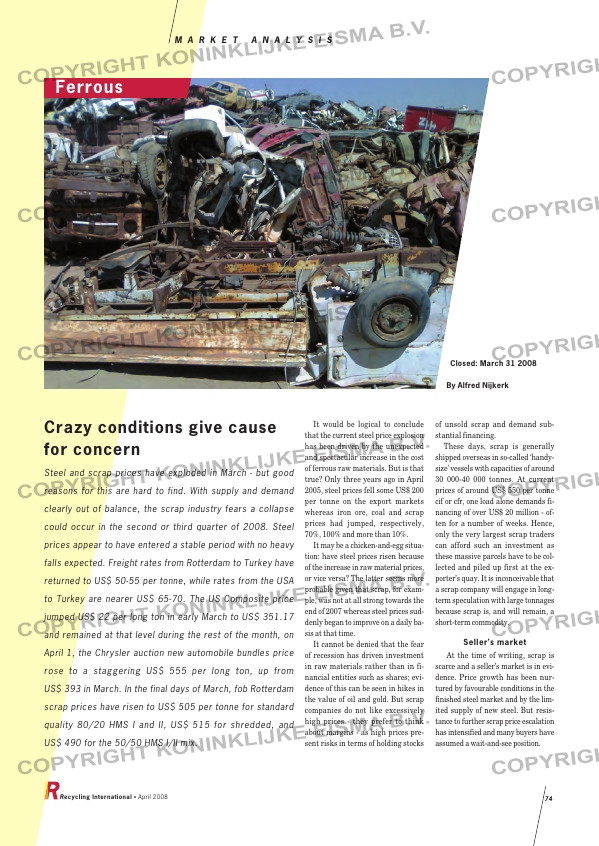Page 74 from: April 2008

Closed: March 31 2008
By Alfred Nijkerk
of unsold scrap and demand sub-
stantial financing.
These days, scrap is generally
shipped overseas in so-called ‘handy-
size’ vessels with capacities of around
30 000-40 000 tonnes. At current
prices of around US$ 550 per tonne
cif or cfr, one load alone demands fi-
nancing of over US$ 20 million – of-
ten for a number of weeks. Hence,
only the very largest scrap traders
can afford such an investment as
these massive parcels have to be col-
lected and piled up first at the ex-
porter’s quay. It is inconceivable that
a scrap company will engage in long-
term speculation with large tonnages
because scrap is, and will remain, a
short-term commodity.
Seller’s market
At the time of writing, scrap is
scarce and a seller’s market is in evi-
dence. Price growth has been nur-
tured by favourable conditions in the
finished steel market and by the lim-
ited supply of new steel. But resis-
tance to further scrap price escalation
has intensified and many buyers have
assumed a wait-and-see position.
M A R K E T A N A L Y S I S
Ferrous
Crazy conditions give cause
for concern
It would be logical to conclude
that the current steel price explosion
has been driven by the unexpected
and spectacular increase in the cost
of ferrous raw materials. But is that
true? Only three years ago in April
2005, steel prices fell some US$ 200
per tonne on the export markets
whereas iron ore, coal and scrap
prices had jumped, respectively,
70%, 100% and more than 10%.
It may be a chicken-and-egg situa-
tion: have steel prices risen because
of the increase in raw material prices,
or vice versa? The latter seems more
probable given that scrap, for exam-
ple, was not at all strong towards the
end of 2007 whereas steel prices sud-
denly began to improve on a daily ba-
sis at that time.
It cannot be denied that the fear
of recession has driven investment
in raw materials rather than in fi-
nancial entities such as shares; evi-
dence of this can be seen in hikes in
the value of oil and gold. But scrap
companies do not like excessively
high prices – they prefer to think
about margins – as high prices pre-
sent risks in terms of holding stocks
Recycling International • April 2008 74
Steel and scrap prices have exploded in March – but good
reasons for this are hard to find. With supply and demand
clearly out of balance, the scrap industry fears a collapse
could occur in the second or third quarter of 2008. Steel
prices appear to have entered a stable period with no heavy
falls expected. Freight rates from Rotterdam to Turkey have
returned to US$ 50-55 per tonne, while rates from the USA
to Turkey are nearer US$ 65-70. The US Composite price
jumped US$ 22 per long ton in early March to US$ 351.17
and remained at that level during the rest of the month, on
April 1, the Chrysler auction new automobile bundles price
rose to a staggering US$ 555 per long ton, up from
US$ 393 in March. In the final days of March, fob Rotterdam
scrap prices have risen to US$ 505 per tonne for standard
quality 80/20 HMS I and I I, US$ 515 for shredded, and
US$ 490 for the 50/50 HMS I/II mix.
RI_034 MA Ferrous:MA Ferrous 04-04-2008 09:08 Pagina 74



